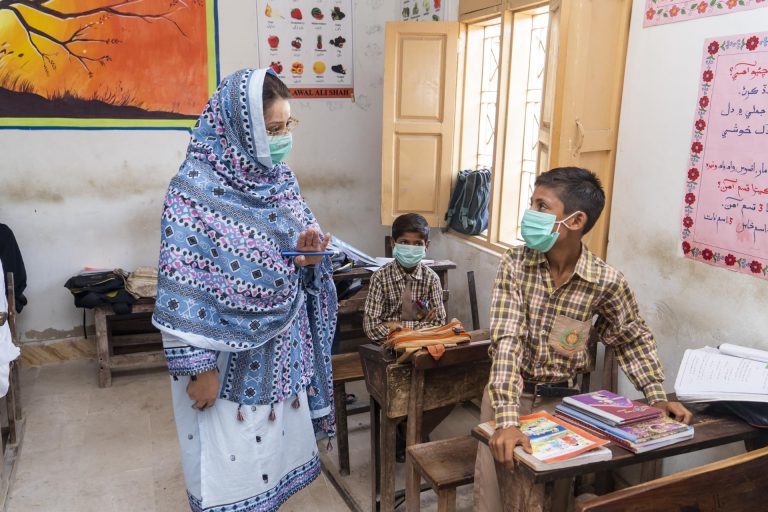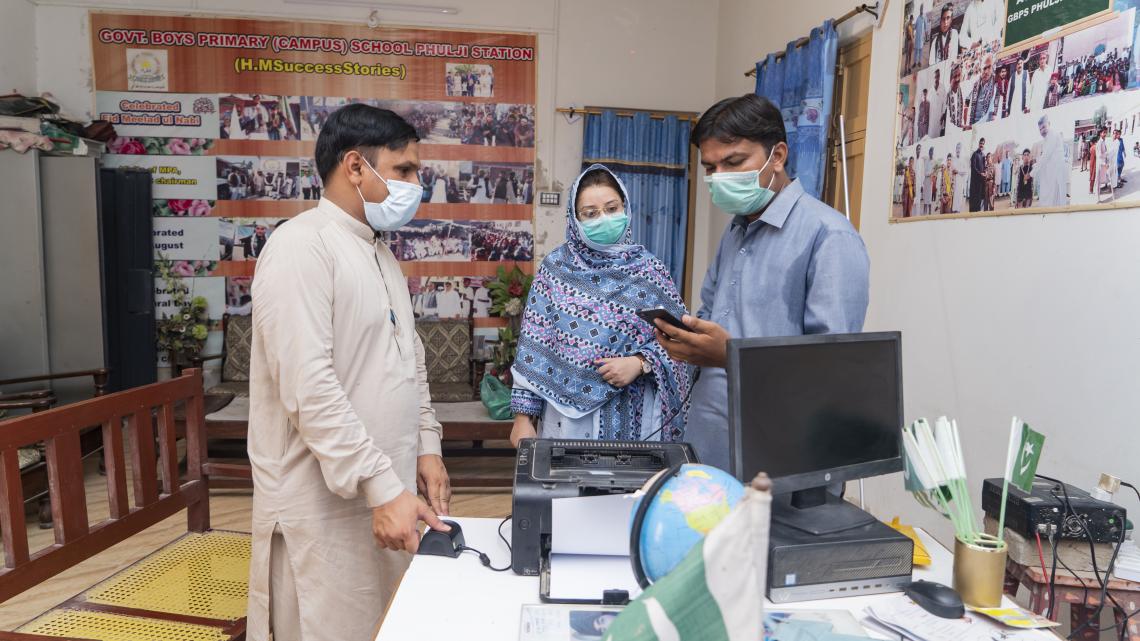
With funding from the European Union, UNICEF has supported the Sindh Education and Literacy Department to develop and implement a robust school monitoring system to ensure teachers’ attendance and functional facilities.
Moeed Hussain
DADU, Sindh
“One of the main reasons why so many students drop out of public schools is the lack of accountability of teachers and staff,” says Ghulam Fatima Ghaloo, Chief Monitoring Officer (CMO) in Dadu, a district of Sindh, the province of Southeastern Pakistan.
For many parents, sending their children to school makes no sense if no teacher is there to receive them. Teacher absenteeism has long been of concern, with another major issue being the lack of adequate facilities.
Born and raised in the small city of Dadu located on the western bank of River Indus, Ghulam Fatima Ghaloo is acutely aware of the difficulties which children, especially girls, face to get an education in the area. Poverty and cultural norms, which discourage girls from going to school, continue to be major hurdles.
“Most parents simply don’t see any point in sending their daughter to school when she is expected to marry young and become a housewife,” Ghulam Fatima says.
“The lack of basic facilities and the poor quality of education in schools eliminate any slim chance a girl may have had of convincing her parents to send her to school. Why would you send your daughter to study in a school which has neither washroom, nor electricity in the scorching heat of Dadu?” she adds. Ghulam Fatima is one of the few girls in her family who completed high school and went on to obtain a higher education. Ever since she graduated, she has worked to promote girls’ education. After volunteering to promote school enrolment in her community, she started working at Sindh Education and Literacy Department to help reduce the barriers that hinder learning.
She quickly realized that monitoring and improving school environment was a priority, as it encourages parent to enroll children.
It has also become a focus of Sindh Education and Literacy Department’s work under the Sindh Technical Assistance for Development through Enhanced Education Program (STA DEEP).
With funding from the European Union and technical support from UNICEF, STA DEEP aims to provide the Department with technical assistance to build more responsive education systems that can provide equitable access to quality education for every child in Sindh.
 One of the components of the program is school monitoring, now done through a mobile application which covers more than 40,000 schools and nearly 120,000 teachers across the province. Sindh School Monitoring System indicators include teachers’ and students’ attendance, textbooks availability, weekly lesson plans prepared by teachers, and functionality of school infrastructure — washrooms, availability of drinking water and electricity, school building condition.
One of the components of the program is school monitoring, now done through a mobile application which covers more than 40,000 schools and nearly 120,000 teachers across the province. Sindh School Monitoring System indicators include teachers’ and students’ attendance, textbooks availability, weekly lesson plans prepared by teachers, and functionality of school infrastructure — washrooms, availability of drinking water and electricity, school building condition.
In Dadu District, Ghulam Fatima supervises a team of 17 monitoring assistants who cover more than 2,000 schools. Equipped with motorcycles, they visit educational facilities unannounced and enter data into the mobile application in real time. All data is then transferred to a Dashboard which Monitoring and Evaluation officials can consult in the districts and in the provincial capital of Karachi.
The mobile application was initially developed in 2018 by Sindh Education and Literacy Department but soon stopped working due to technical issues. It has now been restored and upgraded under the STA DEEP program.
Using a portable biometric device in which teachers must press their thumbs, the mobile app records teachers’ attendance, which has already resulted in a significant drop in absenteeism. Issues in school infrastructure such as a lack of functional washrooms or of access to drinking water can now be brought to the notice of Sindh Education and Literacy Department in real time.
The implementation of the mobile school monitoring application has had its fair share of challenges. Ghulam Fatima and her team faced a lot of resistance from teachers and Teachers’ Unions, as absenteeism and unannounced leaves used to be common. A few teachers have since retired early, while the others have accepted the change.
While the current monitoring system is up and running, efforts are underway to strengthen it further. Sindh Education and Literacy Department is working to develop Geographic Information System (GIS) based monitoring under STA DEEP.
“The majority of students in Sindh are enrolled in government schools that are scattered throughout the province, some in very remote locations,” Shahmir Khan Bhutto, Director General, Monitoring & Evaluation, Sindh Education and Literacy Department, says. “Using technology to improve school monitoring and reinforce the quality of education was logical.”
In Dadu, Ghulam Fatima says that the mobile application has been instrumental to improve equitable access to quality education.
“To fix the issues which schools face, we first need to be able to identify them,” she tells. “The mobile application has helped us remove some of the barriers which children faced to get an education. Some parents have even come forth to thank me. I am proud to be able to bring about positive change through my work.”
____________________
Courtesy: UNICEF (Published on 28 September 2021)
[The report has not been updated according to changed situation as this year the torrential rains and flash floods had inundated thousands of schools across the province]